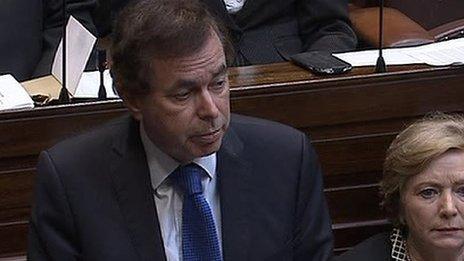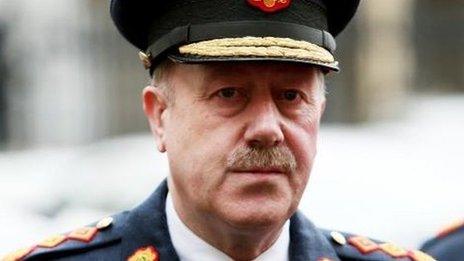Timeline: Irish police secret tapes
- Published

Justice Minister Alan Shatter has been called on to resign after revelations of secret recordings of phone calls at police stations
Details of secret recordings of phone calls to and from police stations across the Republic of Ireland emerged on Tuesday. It was revealed almost 2,500 tapes were kept of calls made in the 1990s.
1980s: Recording equipment is installed at the 26 divisional headquarters of the Irish police force. The equipment is installed primarily to record bomb threats, emergency calls and messages for police officers. It works by recording all incoming and outgoing calls on specific phone lines.
1990s: The original recording system is replaced with dictaphone recorders.
2008: The system is upgraded again with new recording equipment.
29 January 2010: Anthony Holness is arrested in Waterford, County Waterford.
8 February 2010: Mr Holness makes a complaint that he was assaulted by police officers during the course of his arrest. The complaint is forwarded to GSOC (Garda Síochána Ombudsman Commission).

Former Garda Commissioner Martin Callinan resigned on 25 March
12 July 2011: The trial starts of four police officers accused in the case of Mr Holness. During the trial prosecutors attempt to enter into evidence a telephone call recorded between two of the accused at Waterford Police Station. The court held that the recording breached a 1993 law that requires at least one of the parties to have consented to the recording. The trial judge rules the recording as inadmissible.
16 June 2013: GSOC publishes report on the case of Mr Holness and the issue of recorded telephone calls. The report states: "On consideration of the ruling of the court, the Garda Commissioner [Martin Callinan] may wish to re-evaluate his practice regarding the recording of such calls and the consents required if it is to be permissible to use such recordings in evidence."
11 November 2013: Garda Commissioner Martin Callinan consults with Attorney General Máire Whelan on issue of recordings at police stations and establishes a working group.
23 November 2013: Mr Callinan orders a stop to all recordings of non-emergency calls to police stations. Emergency calls are still recorded by law.
10 March 2014: Mr Callinan sends letter to a senior official in the Department of Justice by courier. The letter discloses that there are 2,485 tapes of calls recorded in the 1990s. Individuals recorded include police officers, members of the public and journalists.
23 March 2014: Prime Minister Enda Kenny is briefed on the secret recordings by the Attorney General.

Enda Kenny became aware of the secret recordings on 23 March
24 March 2014: Justice Minister Alan Shatter is briefed by department officials on the contents of the letter sent two weeks previously.
25 March 2014: Mr Callinan resigns. Later that day, details emerge of the Garda Commissioner's letter to the Justice Department on the subject of secret recordings. The government announces there will be a statutory investigation after learning "there was a system in place in a large number of garda stations whereby incoming and outgoing calls were taped and recorded".
26 March 2014: The justice minister denies he previously knew about the secret recordings. In a statement to parliament, he said he first became aware of the Garda Commissioner's letter on Monday, 24 March. He said he had been in Mexico as part of a St Patrick's Day delegation between 15 and 21 March. He added that he was also unaware of the GSOC report, from June 2013. He said: "The simple truth is GSOC did not furnish the report mentioned to me. I am advised that they did not furnish it to my departmental officials nor bring it to the department's attention."